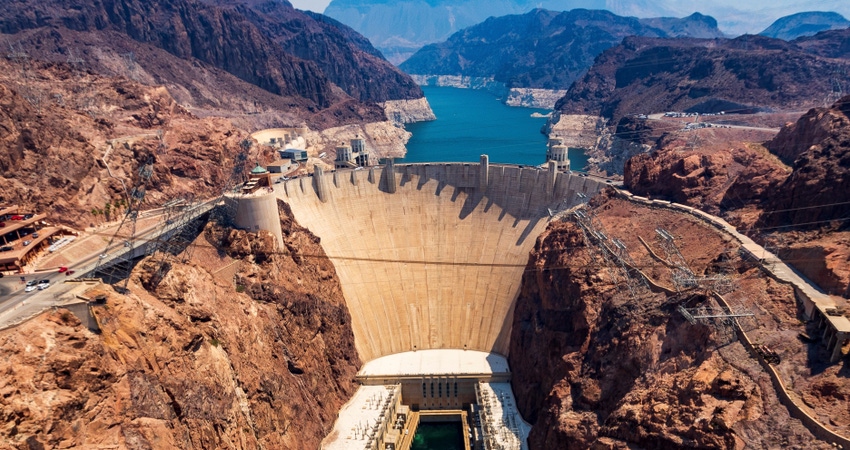
Back when the Colorado River Compact was being negotiated about 100 years ago, water was not viewed as a problem. Officials deemed there was plenty to go around.
Fast forward a century and the seven Colorado River Basin states – particularly the three lower basin states of California, Arizona, and Nevada – are using more than the system can sustain. Nowhere is this more evident than on the chalk-white dry rims of Lakes Mead and Powell, the two large reservoirs on the system that some fear will hit catastrophically low levels in the next couple years.
Chris Harris, executive director of the Colorado River Board of California, says the basin states must grapple with the "new normal" of reduced flows in a river system once thought to provide ample water for the West.
"We're dealing with a new reality, and it's got to change the way we think about putting our long-term plans together," Harris recently told a room full of water attorneys in Scottsdale, Ariz.
New reality
A historic view of hydrology on the Colorado River reveals declining supplies. What was viewed with the Colorado River Compact was negotiated was an annual supply of 18–20-million-acre feet (maf). Today an optimistic supply across the system is closer to 14maf with drought limiting that supply to under 10maf.
The 14maf annual average is bookmarked by years of plenty – 15 of them over the last century at over 20maf. Conversely, 44 of those years, or nearly half of that period, produced under 14maf of natural flow at the Lees Ferry Gaging Station in Arizona.
Viewed another way, Harris points to data that show the worst hydrology years on record since 1906 are all in the 21st Century.
"That's got to be telling for all of us to keep in mind," he said.
Related: Colorado River states collaborate on remaining water
The vulnerability of the Colorado River system was seen in a 2012 basin study report showing the average annual natural flow at Lee Ferry of 13.8maf. Some years were much less.
When California alone has access to 4.4 maf and there are years when the unregulated flow into Lake Powell in the upper Colorado River basin is at or below 5maf, "the math doesn't add up," he said.
Climate scientists similarly point to water scarcity because of severe drought, and the need for the basin states to "pull together, and that includes California." Not only must water managers and urban planners consider water-short years that challenge supply, they must manage for the extreme rain events that can damage and destroy flood control infrastructure.
Big picture
Harris says it's not just the sustainability of the Colorado River system that needs addressing, but the wider Western water reliability of the federal Central Valley Project (CVP) and California's State Water Project (SWP).
On average, California uses about 42-million-acre feet of water annually, Harris says. Of this, about 34maf is used by agriculture with the balance going to municipal and industrial uses. As cities like Phoenix and Las Vegas grew, and their respective states began to utilize their full allotments from the Colorado River, this limited California's take of the Colorado. In the late 1990s, California regularly used over 5maf from the Colorado River. This does not include water used from federal and state projects in California.
By 2019 California's use of the Colorado River had fallen to 3.85maf and the following year California had about 1.4maf of "intentionally created storage" (ICS) water banked in Lake Mead for years like the current. This created concerns in Arizona and Nevada as Lake Mead continued to fall and officials there tried to slow the inevitable Tier 1 shortage call by encouraging MWD to not take all its saved water from Lake Mead.
Because California also has access to CVP and SWP water, Harris said there are huge incentives for water management there to become sustainable and reduce demand for the Colorado River.
"You take an entity like the Metropolitan Water District of Southern California (MWD), which gets about 2.2maf from the State Water Project; they got 100,000-acre feet this year from the State of California," he said.
Related: California fails at drought resilience
This, as others have pointed out, forced MWD to meet its water demand from the Colorado River.
The federal CVP contractors were put in an even worse situation as the U.S. Bureau of Reclamation once again cut their surface water allocations to zero. This significantly impacted California agriculture, which Harris called "a big hit on California's economy."
Harris tied management of the multiple water systems together, saying the management of each can affect water decisions made by the others.
"Every year we have to look at what's going on in the Colorado River basin and we have to look at what's going on in the Sacramento and San Joaquin River systems," he continued. "From there you have to make a decision early on over what your puts and takes are, and where we're going to get our water supplies."
Harris hinted at a possible 15% mandatory statewide water reduction in California. This is in addition to what local water agencies are already doing to conserve water. That decision had not been formally made when this article was written but was said by some to be "likely."
Of the Colorado River system and its sustainability, Harris said the cooperation between the states is necessary if water users are going to have what they need.
"There is a tremendous incentive for the State of California to be part of the solution," he said referring to the sustainability of the Colorado River system. "We're collaborating as three lower basin states because know we're in this together."
About the Author(s)
You May Also Like






